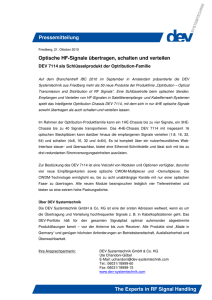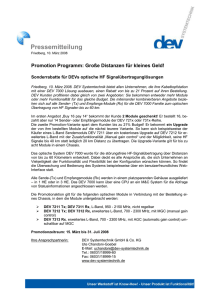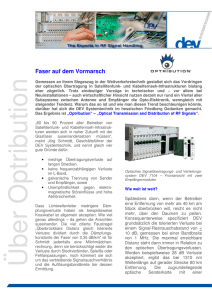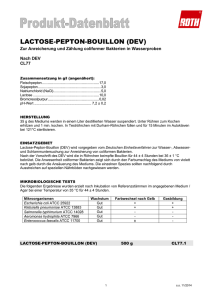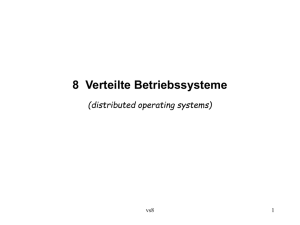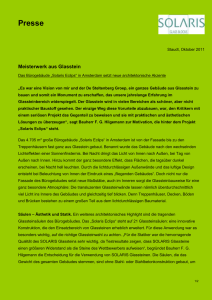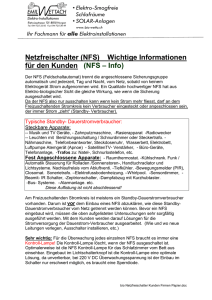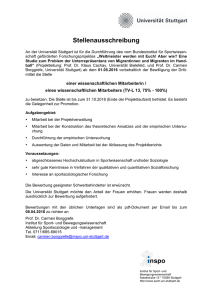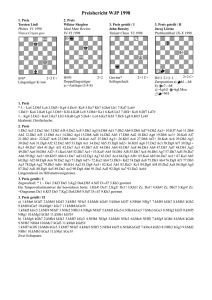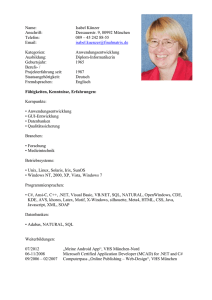Solaris-Admin.ku - TIK
Werbung
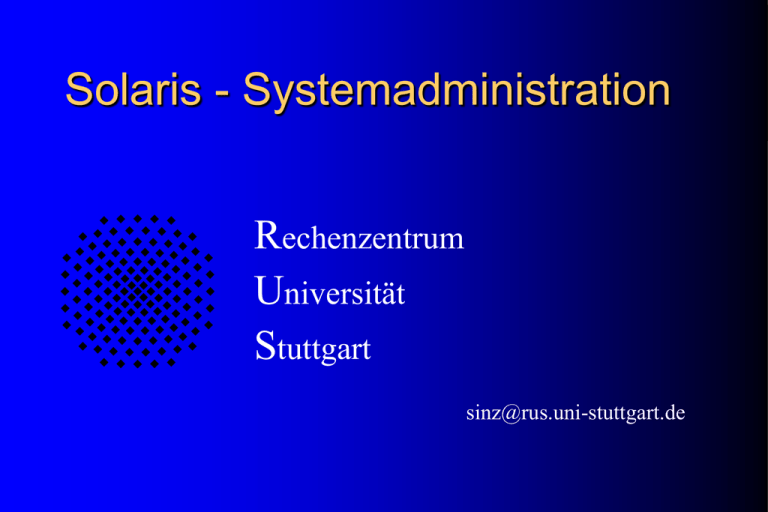
Solaris - Systemadministration Rechenzentrum Universität Stuttgart [email protected] 1. Einführung 1. Einführung Kursablauf Inhalt Umfang Zielgruppe Inhalt 1) 2) 3) 4) 5) 6) 7) 8) 9) Einführung Solaris-Umfang Solaris-Installation Der Monitor Der Bootvorgang Softwareinstallation Patchinstallation Solaris-Dateisysteme Eigene Dateisysteme 10) 11) 12) 13) 14) 15) 16) 17) NFS NIS Benutzerverwaltung Netzwerkverwaltung Systemdienste Backup – Restore SUN-Serviceangebot Weitere Informationen Aufgaben des Sysadmin What are system administrators? In general, sysadmins are those people we complain to when our computer systems aren't working the way we expect. If they can make everything right, then they must be system administrators. Therefore, a system administrator is someone who solves problems in computer and network systems operations. Tasks of the system administrators : The problem set in computing and network operations generally includes all those system tasks users might want to offload -- specification, evaluation, installation, configuration, integration, maintenance, dataintegrity management, upgrade management, automation, security management, performance analysis, failure analysis,failure mitigation, recovery design, recovery implementation, testing, and more. From: Dr. Dobb's Journal Fall 1999 “The future looks bright for problem solvers”. By Barbara Dijker (vice president of the System Administrators' Guild (SAGE)) Ziele Grundlegende UND Solaris-spezifische Infos zum Betrieb von SUN-SPARC-Systemen (nicht INTEL!) SUN-Systeme http://www.sun.de/Produkte/Hardware/index.html 2. Solaris-Umfang Solaris-Software Solaris-Aufbau: – – – – SunOS (Kernel) für SPARC, Intel, PowerPC Open Network Computing (TCP/IP, …) Graphische Oberfläche (CDE, …) Deskset-Tools (Shells, Audiotool, …) Solaris 1 Solaris 2.x Solaris 7 Solaris 8 => SunOS 4.x => SunOS 5.x , bis 5.6 => SunOS 5.7 => SunOS 5.8 (BSD) (SVR4) ( `` ) ( `` ) Zusatz-Software SUN Management Center (SyMON) Oracle 8i Enterprise Edition (Solaris 8) StarOffice Netscape Freeware … DiskSuite DiskSuite-Funktionen Disk mirroring and RAID-5 Hot-spare facility Disk striping UNIX logging Alternate path support A graphical user interface A performance monitor Concatenation and “grow file system” command SNMP traps DiskSuite-Versionen Solaris 7 oder Solaris 2.6 Server Version Bestandteil des Solaris Easy Access Server Solaris 8: base platform 3. Solaris-Installation Installationsarten Neuinstallation Aktualisierung Installationsmethoden Interaktive Installation – Von lokaler CD-ROM [> boot cdrom] WebStart (ab Solaris 8) – Von lokaler CD-ROM [> boot cdrom] Interaktive Netz-Installation – Installations- und Bootserver erforderlich [> boot net] JumpStart – Bei Neusystemen von vorinstalliertem Image [autom.] Custom JumpStart – Für “große” Installationen [> boot net] Installation über Uni-Netz s. “Installation SOLARIS 7 über das Rechnernetz der Universität Stuttgart” auf: http://sunswsrv.rus.uni-stuttgart.de/WSBetreuung_HomePage/SUN/contents/solaris/sol7.html Beginn der Installation Monitor-Modus (Boot/ok-Prompt) – “shutdown –i0” oder – “halt” oder – [Stop]+[A] oder – [Break] boot cdrom (net) Daten für die Installation Hostname IP-Adresse Netzmaske Nameservice Zeitzone Festplattenaufteilung Rechnertyp – Standalone – Server Umfang der Betriebssystem-software Root-Kennwort Festplattenaufteilung - I Benötigter Plattenplatz: – – – – Entire Distribution Plus OEM Support Entire Distribution Developer System Support End User System Support 2.4 Gbytes 2.3 Gbytes 1.9 Gbytes 1.6 Gbytes Create a minimum number of file systems. By default, the Solaris 8 creates only – root (/), – /usr – /swap Festplattenaufteilung – II 0 1 2 3 / Swap Backup /var 4 5 /opt 6 /usr 7 /export Root-FS Swap-Space und /tmp Gesamte Platte (overlap) Variable Daten (Printing, Mail, Logs, Dumps…) Optionale SW (Third Party) System-Programme Heimverzeichnisse, Daten, … 4. Der Monitor Monitor-Befehle Booten – boot [disk|net|cdrom|…] Diagnose – test-all – test floppy (memory/net) Hilfe – help System Informationen – – – – .enet-addr probe-scsi probe-scsi-all show-disks NVRAM-Parameter – – – – printenv Setenv pn pv Setdefault pn Set-defaults NVRAM-Parameter Monitor: – Printenv SunOS: – eeprom > diag-level > keyboard-click?=false > output-device > input-device > boot-command > auto-boot? > watchdog-reboot? > boot-device > security-mode > security-password: > diag-switch? >… =max =screen =keyboard =boot =true =true =disk net =none data not available. =false 5. Der Bootvorgang Booten Einschalten (wenn autoboot=true) Reboot (aus OS, wenn autoboot=true) Boot (im Monitor Prompt) Kernel wird geladen (/kernel/genunix) Nachladen von Kernelmodulen /etc/system verarbeiten Starten des init-Prozesses /etc/system Setzen von Kernelvariablen rootdev: <device name> rootfs: <type> moddir: set [<mod>:]<sym> = <value> # rootdev:/sbus@1,f8000000/esp@… # rootfs:ufs # moddir: /kernel /other/modules # set maxusers=40 # set shmsys:shminfo_shmmax=523288 Ladbare Module exclude: <subdir>/<name> # exclude: sys/shmsys include: <subdir>/<name> # include: other/mymod forceload:<subdir>/<name> # forceload: drv/socal Prozeßinitialisierung durch “init” Init wird vom kernel beim booten gestartet pid = 1 Versetzt das System in den – Angegebenen Runlevel (z.B. init 0) oder – Default-Runlevel laut /etc/inittab Startet die Scripte aus /etc/inittab Runlevel 0 = Shutdown-Zustand 1 = Administrations-Zustand 2 = Mehrbenutzerbetrieb 3 = Mehrbenutzerbetrieb mit Netzwerk 5 = Reboot interaktiv (boot –a) 6 = Reboot (inittab-Default) S oder s = Single-User Zustand (boot –s) /etc/inittab – I zsdjh:~<14:02-66> cat /etc/inittab ap::sysinit:/sbin/autopush -f /etc/iu.ap ap::sysinit:/sbin/soconfig -f /etc/sock2path fs::sysinit:/sbin/rcS >/dev/console … is:3:initdefault: p3:s1234:powerfail:/usr/sbin/shutdown -y -i5 -g0 >/dev/console … s0:0:wait:/sbin/rc0 >/dev/console … s1:1:wait:/usr/sbin/shutdown -y -iS -g0 >/dev/console … s2:23:wait:/sbin/rc2 >/dev/console … s3:3:wait:/sbin/rc3 >/dev/console … s5:5:wait:/sbin/rc5 >/dev/console … /etc/inittab - II s0 : 0 : wait : /sbin/rc0 >/dev/console… Ausgabeumleitung Auszuführendes Kommando Steuerungsbefehl für init -> Runlevel fuer die Abarbeitung der Zeile Kennzeichen der Zeile (Label) Steuerungsbefehle für init wait sysinit initdefault respawn / ondemand off once boot bootwait powerfail powerwait Von init ausgeführte Kommandos Init führt aus: – /sbin/rc? (? =runlevel-Nummer) /sbin/rc? Führt aus: – /etc/rc?.d/S* beim Start – /etc/rc?.d/K* beim Beenden (/etc/rc?.d/* sind Links nach /etc/init.d/*) 6. Softwareinstallation Softwareinstallation Packagemanagement über Befehlszeile – Pkgadd – Pkgrm - Pkginfo - Pkgask - Pkgchk Graphischer Softwaremanager – Swmtool (admintool -> Software) SW-Packages von: Solaris-CDROMs sunswsrv.rus.uni-stuttgart.de:/cdrom_copies/… http://sunswsrv.rus.uni-stuttgart.de/WS-Betreuung_HomePage/SUN/ Third Party … Beispiel: “8Pac Compiler” Installation: /sunswsrv/cdrom_copies/8-PAC/ University_Edition/devpro_v8n1_sparc/installer Lizenz-Installation: – Am Ende frägt "License Installation Tool", nach Datei mit Lizenzkeys oder deren manueller Eingabe – Lizenzfile (für domainname "uni-stuttgart.de") unter sunswsrv:/general_data/Lizenz/Technisches/sunpro.lic,sp Spätere Lizenz-Installation: /etc/opt/licenses/lit 7. Patchinstallation Patches von: SunSolve-CDROMs (Wartungsvertrag) http://sunsolve.sun.de …patches http://metalab.unc.edu/pub/sun-info/sun-patches/ sunswsrv.rus.uni-stuttgart.de:/patches/… http://sunswsrv.rus.uni-stuttgart.de/WS-Betreuung_HomePage/SUN/ Patches über sunswsrv - I Über NFS mounten: sunswsrv.rus.uni-stuttgart.de:/patches Dateien / Unterverzeichnisse: – – – – – – Recommended Patches Patch Reports PatchSummary Unbundled_Recommended_list Files (d) Pcfiles (d) Patches über sunswsrv - II Auswählen der Patches (z.B security Patches) READMEs der einzelnen Patches lesen Patchinstall (halbautomatischen Installieren von Patches) Einzelne Patches oder Patchlist oder “manuelle” Patchinstallation “Manuelle” Patchinstallation Patcheinstallation bis Solaris 2.6 – Patches mit gzip komprimiert => gunzip – installpatch (bei jedem Patch mitgeliefert) – backoutpatch (bei jedem Patch mitgeliefert) Patcheinstallation ab Solaris 7 – Patches mit zip komprimiert => unzip – patchadd – patchrm patchadd / patchrm Einen Patch installieren: – patchadd [-d] [-u] [-B backout_dir] patch Mehrere Patches installieren: – patchadd [-d] [-u] [-B backout_dir] -M patch_dir patch_id... | patch_dir patch_list Auflisten: – patchadd –p (alt: showrev –p) Entfernen: – patchrm [-f] [-B backout_dir] patch_id 8. Solaris-Dateisysteme Dateisystem-Überblick Lokale Dateisysteme – – – – – ufs (default disk-based file system for Solaris) hsfs (CDs) tmpfs (uses swap space) cachefs (NFS or HSFS can be cached) procfs (process file system in memory) Netzwerkdateisysteme – NFS (Network File System) – DFS (Distributed File System) / - Dateibaum - I /bin /dev /devices /etc /export /home /kernel /lost+found /mnt /net /opt /proc /sbin /tmp /usr /var / - Dateibaum - II /bin - Binaries Link auf /usr/bin (UNIX-Betriebssystemkommandos) /export /home - Exportierte Verzeichnisse - Benutzer-Heimverzeichnisse Oft auch unter /export/home! /kernel - Kernel und Kernelmodule /lost+found - fsck-Hilfsverzeichnis /mnt - Leeres Verz. Für Mounts / - Dateibaum - III /net /opt /proc /sbin - Netzverzeichnisse - Optionale Software - Prozeßinformationen (ps) - Startup-Binaries Kommandos für die Initialisierungsphase z.B. rc*-Scripts /tmp - Kernel und Kernelmodule /dev – logische Gerätenamen Verweis auf die physikalischen Geräte in /devices /dsk - Block-Devices /rdsk - Raw-/ Character-Devices /rmt - Tape-Devices /term - Terminal-Devices /cua - Modems /pts - Pseudo- (Software-)Devices /fbs - Frame-Buffer Logische Platten-Devicenamen cwtxdysz Bsp: /dev/dsk/c0t0d0s0 Slice- / Partitionsnummer (0…7) Drive-Nummer (LUN, 0-3) Target-Nummer (SCSI-Adresse, 0-6) Controller-Nummer Logische Tape-Devicenamen X[Y][b][n] Bsp: /dev/rmt/0hn No-rewind SunOS-4.x-Kompatibilität Denisity (l,m,h,u,c) Laufwerksnummer (0 … 127) /devices – physikalische Geräte Aufbau durch: Reconfigure-Boot – boot -r – Boot mit Datei “reconfigure” im /-Verzeichnis drvconfig zur Laufzeit (link auf devfsadm bei Sol.8) devfsadm (Sol. 8 / Hot-Plug) zur Laufzeit Physische-Devicenamen /devices/sbus@1f,0/espdma@e,8400000/esp@e,8800000/sd@0,0:a SCSI-Controller SBUS-Slot SCSI-Disk SCSI-Adresse 0 Partition 0 (a) ! Hardware-spezifische Adressen ! /etc - Konfigurationsdateien Konfigurationsdateien (u.a): – passwd, group, vfstab, … Konfigurationsverzeichnisse (u.a.): – – – – – – – /dfs /cron.d /default /inet /init.d /rc?.d /skel - dfstab, sharetab, … - cron.deny, … - Standard-Systemkonfiguration - Netzdateien (hosts, …) - Startdateien - Startdateien (Link auf init.d) - Dateien für neuen Benutzer /usr - Systemdateien /bin /include /lib /openwin /sadm /sbin /share /ucb - UNIX-Kommandos - Header-Files für SW-Entwicklung - Libraries - OpenWindows, X-Kommandos - SW-Administration - Systemkommandos - Architekturunabhängige Daten - BSD-Kompatible Binaries /var – variable Systemdateien /adm /cron /ldap /log /sadm /spool /yp - Log-/Accounting-Dateien (messages) - Cron-Logs - Lightweight Directory Access Protocol - syslog - Software-Administration - Spooling für Mail, Printing, … - NIS-Maps 9. Eigene lokale Dateisysteme Erstellen von Dateisystemen Platte anschliessen Platte formatieren Platte partitionieren Dateisystem anlegen Dateisystem einhängen Dateisystem prüfen => boot –r => format => format => newfs => mount => fsck Format – FORMAT-MENU disk format partition label current repair analyze inquiry volname - select a disk - format and analyze the disk - select (define) a partition table - write label to the disk - describe the current disk - repair a defective sector - surface analysis - show vendor, product and revision - set 8-character volume name Format – PARTITION-MENU 0 - change `0' partition 1 - change `1' partition 2 - change `2' partition 3 - change `3' partition 4 - change `4' partition 5 - change `5' partition 6 - change `6' partition 7 - change `7' partition print - display the current table label - write partition map and label to the disk quit Format – Partitionstabelle partition> pr Part Tag Flag 0 root wm 1 swap wu 2 backup wm 3 var wm 4 unassigned wm 5 unassigned wm 6 alternates wm 7 alternates wm Cylinders 0 - 890 891 - 1113 0 - 7505 1114 - 2004 2005 - 2227 0 2228 - 4008 4009 - 7505 Size 2.00GB 513.07MB 16.86GB 2.00GB 513.07MB 0 4.00GB 7.86GB Blocks (891/0/0) 4198392 (223/0/0) 1050776 (7506/0/0) 35368272 (891/0/0) 4198392 (223/0/0) 1050776 (0/0/0) 0 (1781/0/0) 8392072 (3497/0/0) 16477864 Format – Tags / Flags Tag – A numeric value that usually describes the file system mounted on this partition. – 0=UNASSIGNED 1=BOOT 2=ROOT 3=SWAP 4=USR 5=BACKUP 6=STAND 7=VAR 8=HOME 9=ALTERNATES Flag – wm – wu – rm Partition is writable and mountable. Partition is writable and unmountable. (Default state for swap areas) Partition is read only and mountable. newfs example# newfs -Nv /dev/rdsk/c0t0d0s6 mkfs -F ufs -o N /dev/rdsk/c0t0d0s6 1112940 54 15 8192 1024 16 10 60 2048 t 0 -1 8 /dev/rdsk/c0t0d0s6: 1112940 sectors in 1374 cylinders of 15 tracks, 54 sectors 569.8MB in 86 cyl groups (16 c/g, 6.64MB/g, 3072 i/g) super-block backups (for fsck -b #) at: 32, 13056, 26080, 39104, 52128, 65152, 78176, 91200, 104224, ... Dateisystem einhängen - I example# mount /dev/dsk/c0t1d0s6 /scr2 example# df -k Filesystem kbytes used /dev/dsk/c0t0d0s0 1914318 1693736 /proc 0 0 swap 46208 80 sunswsrv.rus.uni-stuttgart.de:/patches 3297328 3177016 /dev/dsk/c0t1d0s6 980030 9 example# umount /src2 avail 163153 0 46128 capacity Mounted on 92% / 0% /proc 1% /tmp 87344 882018 98% /sunswsrv/patches 1% /scr2 Dateisystem einhängen - II example# vi /etc/vfstab #device device mount FS fsck mount mount #to mount to fsck point type pass at boot options #-----------------------------------------------------------------------------------------------/proc /proc proc no /dev/dsk/c0t0d0s0 /dev/rdsk/c0t0d0s0 / ufs 1 no /dev/dsk/c0t0d0s1 swap no swap /tmp tmpfs yes /dev/dsk/c0t1d0s6 /dev/rdsk/c0t1d0s6 /scr2 ufs 2 no - example# mountall Der Automounter (autofs) - I Automatisches Ein- und Aushängen von Dateisystemen bei Bedarf Lokale und entfernte (NFS-) Dateisysteme Starten: – /etc/init.d/autofs start – /etc/rc2.d/S74autofs Stoppen: – /etc/init.d/autofs stop (manuell) (beim booten) Der Automounter (autofs) - II Konfiguration über “automounter-Maps” – Master-Map – Direkte Maps (/etc/auto_master) “/-” als Kennzeichen in Master-Map Absolute Pfade – Indirekte Maps Verzeichnis angegeben in Master-Map Relative Pfade – Ausführbare Maps – Build-In-Maps (/net) Dateisystem prüfen example# umount /dev/dsk/c0t1d0s6 example# fsck /dev/rdsk/c0t1d0s6 ** /dev/rdsk/c0t1d0s6 ** Last Mounted on /scr2 ** Phase 1 - Check Blocks and Sizes ** Phase 2 - Check Pathnames ** Phase 3 - Check Connectivity ** Phase 4 - Check Reference Counts ** Phase 5 - Check Cyl groups 3 files, 9 used, 980021 free (13 frags, 122501 blocks, 0.0% fragmentation) Sonstige Dateisystem-Befehle df - number of free disk blocks and files du - summarize disk usage ff - list file names and statistics of a FS fuser - identify processes using a file sync - Update Filesystem tunefs - tune up an existing file system Auswechselbare Datenträger eject - eject media such as CD-ROM and floppy example# eject cd fdformat - format floppy / PCMCIA memory card example# fdformat /dev/diskette mt - magnetic tape control example# mt -f /dev/rmt/0 status Volume-Management /etc/init.d/volmgt start volcheck /etc/init.d/volmgt stop - check entpr. /etc/vold.conf – Bei “manuellem” Umgang mit Datenträgern. Sonst Fehlermeldung “device busy” Swap Ueberprüfen: – example# swap -s Hinzufügen: – example# mkfile -v 32m /swap2fs – Example# swap -a /swap2fs (Ggf. in /etc/vfstab: /swap2fs - - swap - no -) Entfernen: – Example# swap -d /swap2fs – example# rm /swap2fs // Swap-File löschen 10. Network File System (NFS) Network File System (NFS) NFS-Server /root-Verzeichnis /... /export /home /alfons /berta /caecilie /dora /... NFS-Client(s) /root-Verzeichnis /... /home /alfons /berta /caecilie /dora /... /... /... # share /export/home # mount NFS-Server:/export/home /home Vorteile von NFS Konsistenter Zugriff mehrerer Rechner auf die gleichen Dateien Transparent fuer den Benutzer Heterogene Umgebungen Reduziert Administrationsaufwand Reduziert Plattenkosten NFS-Dateisysteme exportieren - I share [-F FSType] [-o options] [-d descr] [ pathname] – -o ro|rw|root[=access_list] wobei access-list: [-]client[:[-]client]... [-]netgroup[:[-]netgroup]... [-].domain name suffix[:[-].domain name suffix] [-]@network[:[-]@network] Beispiel: “share -F nfs -o [email protected]:[email protected] /disk” NFS-Dateisysteme exportieren - II share [-F FSType] [-o options] [-d descr] [ pathname] – – – – -o anon=uid -o log=tag -o nosub -o nosuid (uid für unbekannte Benutzer) (tag ist definiert in /etc/nfs/nfslog.conf) (keine Mounts von Unterverzeichnissen) (setuid, setgid verboten) NFS-Dateisysteme exportieren - III unshare [pathname] shareall [-F FSType [,FSType ...]] [ -| file ] unshareall [-F FSType [,FSType ...]] /etc/dfs/dfstab - Default-Datei für [un]shareall - enthält share-Befehle - Autom. Ausführung in run-level 3 NFS-Dateisysteme testen share showmount [-a] [-d] [-e] [host] dfmounts [host] dfshares [host] nfsstat [-cnrsmza] mount [ -p | -v ] (auf dem Client) NFS-Dateisysteme importieren - I Manuelles Ein- / Abhängen einzelner Dateisysteme: – – mount [–r] <server>:<pfad> <Mountpunkt> umount [–f] <Mountpunkt> Manuelles Ein- / Abhängen über vfstab: – – mountall [ -F FSType ] [ -l | -r ] umountall [ -k ] [ [ -h host ] | [ -F FSType ] [ -l | -r ] ] NFS-Dateisysteme importieren - II example# vi /etc/vfstab #device device mount FS fsck mount mount #to mount to fsck point type pass at boot options #-----------------------------------------------------------------------------------------------/dev/dsk/c0t0d0s0 /dev/rdsk/c0t0d0s0 / ufs 1 no /proc /proc proc no /dev/dsk/c0t0d0s1 swap no swap /tmp tmpfs yes appl-b:/raid - example# mountall /appl/raid nfs - yes rw,hard,timeo=50, \ bg,nosuid,largefiles NFS-Dateisysteme importieren - III Einhaengen beim Booten: – über /etc/vfstab Autom. Einhängen bei Bedarf: – Automounter (autofs) NFS starten / stoppen NFS-Server starten (für Export) – Manuell: “/etc/init.d/nfs.server {start | stop}” – Beim Booten: Start in rc3.d, (Nur wenn dfstab vorhanden!) Stop in rc{0,1,S}.d NFS-Client Prozesse starten – Manuell: “/etc/init.d/nfs.client {start | stop}” – Beim Booten: Start in rc2.d, Stop in rc0.d NFS - Prozesse NFS-Server Prozesse: – – – – nfsd mountd (nfslogd) rpcbind Bearbeiten der Client-Anfragen (mehrf.) Einhängen loker Dateisysteme (nur bei Dateisystemen mit log-Option) (gestartet von: /etc/init.d/rpc) NFS-Client Prozesse (laufen auch auf Server): – lockd – statd Locking von Dateien / Dateisätzen Statusverarbeitung für Wiederanlauf nach Crash Das chachfs – Dateisystem - I Vorteile: – Schnellerer Zugriff auf langsame Dateisysteme (NFS) – Reduzierung der Netzwerkbelastung (bei NFS) Tipps: – Nur häufig verwendete Dateisysteme cachen (homes) – cachefs auf mögl. unbelasteter Platte (eigene Partition) – AnswerBook2 · System Administration Guide, Volume I: http://sunswsrv.rus.unistuttgart.de:8888/ab2/coll.47.5/SYSADV1/@Ab2PageView/44877;td=1? Das chachfs – Dateisystem – II Anwendung read write (around) cachefs lokal entfernt Netzwerk read write NFS chachfs – Verwaltung - I Anlegen – cfsadmin -c [ -o cacheFS-parameters ] cache_directory Beispiel: # cfsadmin -c /cache Benutzen – mount –F cachefs [generic_options] –o backfstype=nfs, cachedir=dir [specific_options] [-O] mount_point Beispiel: # mount -F cachefs -o backfstype=nfs,cachedir=/cache,demandconst 129.69.110.10:/raid /raid chachfs – Verwaltung – II Testen – cfsadmin -l cache_directory - List file systems + statistics – cachefsstat - Cache File System statistics Warten/Pflegen – cachefspack [ -i| -p| -u] [-f pack-list] [-U cache-dir] [file]... Prüfen der Konsistenz – cfsadmin -s {mntpt1 ....} | all geht nur, wenn mit der Option “demandconst” gemountet. chachfs – Verwaltung - III Löschen – cfsadmin -d {cache_ID | all} cache_directory Beispiel: # umount /raid # cfsadmin -d modsrv01.modus.uni-stuttgart.de:_raid:_raid /cache (cache-id aus # cfsadmin -l cache-directory) NFS - Literatur Verwaltung von Unix- Netzwerken mit NFS und NIS. (Hal Stern) Taschenbuch (1995) OReilly/VVA; ISBN: 3930673258 Preis: DM 69,00 Linux-/Windows Integration mit NFS: http://wwwab.fh-wedel.de/rechnernetze/projekte/nfs/ 11. Network Information Service (NIS) Verzeichnisdienste Beispiel: Telefonauskunft ? Arten von Verzeichnisdiensten Globale Verzeichnisdienste – DNS – X500 / LDAP Lokale Verzeichnisdienste – NIS (YP) – NIS+ – /etc - Dateien Auswahl von Verzeichnisdiensten Syntax von /etc/nsswitch.conf <database>: [files] [nis] [nisplus] [dns] [ldap] ... Beispiel# cat /etc/nsswitch.conf passwd: group: # hosts: networks: protocols: compat files nis - beachte “+” Eintrag in /etc/passwd - kein “+” Eintrag in /etc/group dns nis files nis [NOTFOUND=return] files - "files" only if nis is down nis [NOTFOUND=return] files - "files" only if nis is down NIS – Verzeichnisdienste (Maps) bootparams group.bygid hosts.byname ethers.byaddr group.byname mail.aliases ethers.byname hosts.byaddr mail.byaddr netgroup.byhost netid.byname networks.byname netgroup.byuser netgroup netmasks.byaddr networks.byaddr passwd.adjunct. byname passwd.byname protocols.bynumber services.byservice passwd.byuid rpc.bynumber ypservers protocols.byname\ services.byname NIS – Architektur NIS-Domäne: “hell” NIS-Domäne: “dunkel” Master-Server Master-Server MapTransfer MapTransfer Slave-Server Client MapTransfer Slave-Server NIS-Requests NIS-Requests Client Client Client Client Slave-Server NIS-Requests Client Client Client Client NIS - Installation NIS als Nameservice bei Solaris-Installation auswählen Nachträglich installieren: – SUNWypr – SUNWypu root-Teile von YP usr-Teile von YP Beispiel: # cd /sunswsrv/cdrom_copies/Solaris_8/sol_8_sparc_2/Solaris_8/Product # pkgadd –d . # ... auswählen von SUNWypr und SUNWypu Dateien, Verz. auf NIS-Master Installation: /var/yp/Makefile /var/yp/binding/... /usr/bin/... /usr/lib/netsvc/yp/... Map-Generierung ...ypservers NIS-Befehle spez. NIS-Befehle Konfiguration: /var/yp/<domain>/... /var/yp/<source>/... /etc/defaultdomain Maps Quell-Dateien Domänenname NIS - Konfiguration 1. Planung der NIS-Domäne 2. Master-Server vorbereiten Master-Server konfigurieren NIS-Prozesse auf Master-Server starten 3. 4. 5. 6. Slave-Server konfigurieren NIS-Klienten konfigurieren Planung der NIS-Domäne Festlegung des Domänennamens – Max. 256 Zeichen Festlegung der Master-Server – Üblich: 1 Master-Server / Domäne – Möglich: 1 Master-Server / Map Festlegung der Slave-Server Bestimmung der Klienten Master-Server vorbereiten - I Domäne setzen # domainname <my-domain> # domainname > /etc/defaultdomain Pfad zu “make” gesetzt? # set path=($path /usr/ccs/bin) Verzeichnis für Quelldateien anlegen ($DIR) # mkdir /var/yp/<src> Verzeichnis für Kennwortdatei anlegen ($PWDIR) # mkdir /var/yp/<pwdir> Master-Server vorbereiten - II Quelldateien für Map-Konvertierung vorbereiten – Kopiere Quelldateien -> $DIR (NICHT /etc/mail/aliases) – Kopiere /etc/passwd, /etc/shadow -> $PWDIR – Kommentare, ... aus Quelldateien entfernen Makefile anpassen - DIR= /var/yp/<src> PWDIR= /var/yp/<pwdir> all: passwd group ... gewünschte Maps eintragen Neueinträge für eigene (nicht-standard) Maps passwd-Map mit shadow Nachteil: Zwei Dateien zu pflegen! nsswitch.conf - Eintrag: – “passwd compat” oder “passwd files nis” Kopieren der Originale: – cp /etc/passwd $PWDIR – cp /etc/shadow $PWDIR Bereinigen der Kopien – lokale Einträge (root!) entfernen Eintrag NIS-Verweis (bei “compat”) - “+” in /etc/passwd, /etc/shadow passwd-Map ohne shadow nsswitch.conf - Eintrag: – “passwd compat” oder “passwd files nis” Konvertieren der Originale: – > cut -d: -f1,2 /etc/shadow > /tmp/eins – > cut -d: -f3- /etc/passwd > /tmp/zwei – > paste -d: /tmp/eins /tmp/zwei > $PWDIR/passwd Bereinigen der Kopien – lokale Einträge (root!) entfernen Eintrag NIS-Verweis (bei “compat”) - “+” in /etc/passwd, /etc/shadow Master-Server konfigurieren Nameservice=lokal setzen (nsswitch.conf: “files”) Slaveserver in /etc/hosts eintragen /usr/sbin/ypinit –m – Slaveserver? – terminate at nonfatal error? – destroy existing files in the /var/yp/<domainname>? => Ruft “make” auf Nameservice=nis setzen (nsswitch.conf: “... nis”) Master-Server starten/stoppen Automatisch beim Booten / Shutdown: /etc/init.d/rpc [start | stop] Aus Befehlszeile: /usr/lib/netsvc/yp/ypstart /usr/lib/netsvc/yp/ypstop NIS-Prozesse ypupdated - changing NIS information (MS) yppasswdd - modifying NIS password file (MS) ypxfrd - NIS Transfer Daemon (MS) ypserv - NIS Server (S) ypbind - NIS binder process (C/S) Änderungen der NIS-Quelldateien Editieren der Quelldateien im YP-Verzeichnis: bsp# vi /var/yp/src/passwd Maps neu generieren (nach jeder Änderung!): bsp# cd /var/yp bsp# make [map] Slave-Server konfigurieren Domäne setzen # domainname <my-domain> # domainname > /etc/defaultdomain NIS-Server in /etc/hosts eintragen Client initialisieren – /usr/sbin/ypinit –c NIS-Restart – /usr/lib/netsvc/yp/ypstop; /usr/lib/netsvc/yp/ypstart /usr/sbin/ypinit –s <master-server> Slave-Server synchronisieren Manuell – yppoll <map> – ypxfr [options] <map> Cron (SUN-Standard-Scripts in /usr/lib/netsvc/yp) – ypxfr_1perday* – ypxfr_1perhour* – /ypxfr_2perday NIS-Klienten konfigurieren Domäne setzen # domainname <my-domain> # domainname > /etc/defaultdomain NIS als Nameservice auswählen nsswitch.conf ypinit –c Liste der Server eingeben. (Wird in “/var/yp/binding/<domain>/ypservers” gespeichert) Achtung: NIS-Client wartet beim Booten bis sich ein NIS-Server meldet!! NIS-Befehle ypcat - NIS-Maps ausgeben ypwhich - Name des NIS server ausgeben domainname - anzeigen/setzen akt. domainname ypset - NIS-Server setzen 12. Benutzerverwaltung Kommandos und Dateien Dateien/Verzeichnisse /etc/passwd /etc/shadow /etc/group /etc/skel dot-Files Kommandos user{add | mod | del} group{add | mod | del} passwd /etc/passwd root : x : 0 : 1 : Super-User : / : /sbin/sh 1 2 3 4 5 6 7 [1] Benutzername (+[@netgrp1:x:::::]) [2] Platzhalter für Kennwort (/etc/shadow) [3] UID [4] GID [5] Kommentar [6] Heimverzeichnis [7] Benutzershell (muß in /etc/shells eingetragen sein!) /etc/shadow root : 7sCkol9HVx : 11031 : : : : : : 1 2 3 4 5 6 7 8 9 [1] Benutzername [2] Verschlüsseltes Kennwort [3] Letzte Änderung des Kennworts (Tage seit 1.1.70) [4] minimale Zeit für unverändertes Kennwort [5] maximale Zeit Tage der Kennwortgültigkeit [6] Zeit vor Benutzerwarnung des Ablaufs [7] Zeit für Accountsperrung bei Nichtbenutzung [8] Account-Verfallsdatum [9] - ungenutzt - /etc/group bspgroup : : 4711 : anna,otto 1 2 3 4 [1] Gruppenname [2] Kennwort [3] GID [4] Gruppenmitglieder NIS-Benutzer/Gruppen Mehr Benutzer und Gruppen (von NIS) => Eintrag in /etc/nsswitch.conf: passwd: compat => Eintrag “+” erlaubt group: files nis /etc/skel Initialdateien des Benutzers – Werden beim Anlegen ins Heimverzeichnis kopiert Solaris-Standarddateien (Installation) – local.cshrc, local.login, local.profile Weitere dot-Files: – .logout, .Xdefaults, .kshrc, .rhosts, .xinitrc, .project, … Und Verzeichnisse: – .dt, … Benutzer Anlegen useradd [-c comment] [-d dir] [-e expire] [-f inactive] [-g group] [ -G group [ , group...]] [ -m [-k skel_dir]] [ -u uid [-o]] [-s shell] login example# useradd -c "O. Muster" -d /home/muster -g 77 -u 66 -m -s /bin/csh muster Ändern usermod [ -u uid [-o]] [-g group] [ -G group [ , group...]] [ -d dir [-m]] [-s shell] [-c comment] [-l new_name] [-f inactive] [-e expire] login Löschen userdel [-r] login Gruppen Anlegen groupadd [ -g gid [-o]] Ändern groupmod [ -g gid [-o]] [-n name] Löschen groupdel group passwd Repository (-r) – passwd [ -r files| -r ldap| -r nis| -r nisplus] [name] Lokale passwd-Datei (-r files) – – – – passwd [ -r files] [-egh] [name] passwd [ -r files] -s [-a] passwd [ -r files] -s [name] passwd [ -r files] [ -d| -l] [-f] [-n min] [-w warn] [-x max] name /etc/nsswitch.conf Wird untersucht um Standard-Repository festzulegen Bsp: passwd: compat (==> files nis) Disk-Quotas - I Dateisystem für Quotas konfigurieren – rq als mount-option in /etc/vfstab setzen – # touch quotas (im obersten Verz. des Dateisystems) – # chmod 600 quotas Quotas für einzelnen Benutzer setzen – # edquota username “fs /home1 blocks (soft = 50, hard = 90) inodes (soft = 0, hard = 0)” Quotas für mehrere Benutzer setzen – # edquota -p bob mary john Disk-Quotas - II Konsistenzprüfung – # quotacheck [-v] -a | filesystem Quotas aktivieren – # quotaon [-v] -a | filesystem ... Quotas deaktivieren – quotaoff [-v] -a | filesystem ... Quotas für Benutzer anzeigen – quota [ -v ] [ username ] Quotas für Datesystem anzeigen – repquota [-v] –a | filesystem ... 13. Netzwerkverwaltung Netzwerkkonfiguration – I /etc/nodename Die Daten können von der Installation noch richtig gesetzt sein /etc/hostname.interface !! Hostname oder IP-Adr. eintragen Hostname eintragen /etc/defaultrouter Name oder IP-Adr. des Default-Routers eintragen /etc/hosts Name und IP-Adr. des Hosts und des Default-Routers eintragen /etc/netmasks Netzmaske eintragen (reboot) Netzwerkkonfiguration – II ifconfig – (Interface-Konfig. ohne reboot) ex# ifconfig hme0 inet 129.143.67.51 netmask 255.255.255.0 broadcast 129.143.67.255 up route add – (Default-Router angeben) ex# route add default 129.143.67.62 1 Internet services daemon - inetd inetd startet weitere Daemons bei Bedarf – Vorteile Diese Daemons belegen nicht ständig Speicherplatz Man kann sehr leicht tcpwrapper einsetzen – Nachteile Daemon muß bei jeder neuen Verbindung neu gestartet werden Initialisierung des Daemons kann lange dauern Der inetd wird über /etc/inetd.conf konfiguriert. /etc/inetd.conf # inetd.conf This file describes the services that will be available # through the INETD TCP/IP super server. To re-configure # the running INETD process, edit this file, then send the # INETD process a SIGHUP signal. # These are standard services. ftp stream tcp nowait root /usr/sbin/tcpd in.ftpd -l -a telnet stream tcp nowait root /usr/sbin/tcpd in.telnetd # # Pop and imap mail services pop-2 stream tcp nowait root /usr/sbin/tcpd ipop2d pop-3 stream tcp nowait root /usr/sbin/tcpd ipop3d imap stream tcp nowait root /usr/sbin/tcpd imapd … /etc/services #ident "@(#)services 1.16 97/05/12 SMI" /* SVr4.0 1.8 */ # # Network services, Internet style # Echo 7/tcp echo 7/udp ... ftp 21/tcp telnet 23/tcp smtp 25/tcp mail pop2 109/tcp pop-2 # Post Office Protocol - V2 pop3 110/tcp # Post Office Protocol - Version 3 pop-2 109/tcp # Post Office imap 143/tcp imap2 # Internet Mail Access Protocol v2 ... Weitere Konigurationsdateien /etc/ethers - Ethernet address to hostname database ex# cat /etc/ethers cc:00:08:00:00:03 ex.rus.uni-stuttgart.de 00:a0:24:a9:29:de zsdsinz.rus.uni-stuttgart.de … /etc/resolv.conf - name server configuration ex# cat /etc/resolv.conf nameserver 129.69.1.28 nameserver 141.58.231.9 domain rus.uni-stuttgart.de Netzwerküberwachung netstat route traceroute snoop nslookup ping rpcinfo ndd arp - show network status - manipulate the routing tables - print the route to a host - capture and inspect network packets - query name servers interactively - send Echo-Request to network host - report RPC information - get and set driver parameters - address resolution display and control 14. Systemdienste Syslogd - log system messages /etc/syslog.conf Standars-Logs: Konfigurationsdatei – /var/adm/messages – /var/log/* {syslog|authlog} – console – Mail an root cron – clock daemon Führt Befehle zu vorbestimmten Zeiten aus cron-Befehle: – crontab –{e | l | r} edit | list | remove der crontab-Datei des Benutzers cron-Dateien: – – – – /etc/cron.d/cron.{allow|deny}zugelassene Benutzer /etc/default/cron cron-Defaults /var/cron/log cron-Log /var/spool/cron/crontabs crontabs der Benutzer crontab - Format 33 08 * * * /u/rus/sinz/cmd/chk_adsm.sh > /dev/null 2>&1 1) 2) 3) 4) 5) 6) minute (0-59), hour (0-23), day of the month (1-31), month of the year (1-12), day of the week (0-6 with 0=Sunday) Auszuführender Befehl 15. Backup / Restore Backup / Restore - Befehle cp tar cpio ufsdump ufsrestore TSM, siehe: volcopy dd compress / uncompress pack / unpack gzip / gunzip http://servwww.rus.uni-stuttgart.de/ZSDNEU/adsm/ADSM_main_text.html TSM – Backup (Installation) Software (tar-file) holen von: ftp://ftp.rz.uni-karlsruhe.de /pub/tsm/mirror/maintenance/client/.../LATEST/ tar -file ausgepacken Package installieren # pkgadd -d <dir><package> Auswahl: IBMadsm-c (Client). TSM – Backup (Konfiguration) dsm.opt anpassen: – SErvername – DOMAIN rusadsm1 / dsm.sys anpassen: – SErvername – TCPServeraddress – NODename Zu sichernde Verzeichnisse rusadsm1 rusadsm1.rus.uni-stuttgart.de INS_HOST backup.excl anpassen (ausgeschl. Verzeichnisse) Scheduler-Eintrag in /etc/inittab: adsm::once:/opt/IBMadsm-c/dsmc sched >/dev/null 2>&1 & Mail an [email protected] TSM – Backup (Bedienung) Aufruf Graphisches Werkzeug: – dsm Kommandozeile: # dsmc Backup Systemplatte Single User Mode (wenn möglich) # shutdown -g30 –y Backup / auf Band # ufsdump 0ucf /dev/rmt/0 / (/usr, /opt, …) Zurück in den Multi User Mode – Cntrl+D Restore Systemplatte # mount /dev/dsk/c0t3d0s0 /mnt (neue Platte) # cd /mnt # ufsrestore rvf /dev/rmt/0 # cd / # umount /mnt # installboot \ /usr/platform/sun4m/lib/fs/ufs/bootblk \ /dev/rdsk/c0t3d0s0 # init 6 (Reboot) Notboot von Solaris boot cdrom (im Monitor-Modus) Warten bis OpenWindows gestartet ist (Systeminstallations-Fenster erscheint) Mausklick auf Workspace “Command Tool” öffnen => Kommandoausführung (ufsrestore, ….) 16. Serviceangebot von SUN Sun Professional Services Sun Support Services Sun Educational Services Sun Professional Services IT-Architekturberatung Planung von unternehmensweiten heterogenen Netzwerken Systemintegration und Implementierung von kundenspezifischen Lösungen Projektmanagement, Generalunternehmerschaft Sun Support Services SunSpectrum PLATIN - Mission-Critical Support SunSpectrum GOLD - Business-Critical Support SunSpectrum SILBER - System Support SunSpectrum BRONZE - Self Support SunSolve Service Online Informationsdatenbank, zum Teil nur für Kunden mit SunSpectrum-Servicevertrag [http://sunsolve.sun.de/] Gezielte Suche oder Durchblättern der Information Download von Patches Zugriff auf diagnostische Werkzeuge Automatisches Update von ausgewählten Dokumenten (Auf CD-ROM, falls kein Internet-Anschluss vorhanden) Sun Educational Services Standard Trainings – Solaris, Java, Netzwerke, Applikationen, … (bei SUN) Indivduelle Firmen Trainings – Standard- oder individuelle Inhalte vor Ort Enterprise Consulting Services – Management von Ausbildungsprojekten Technology Based Training – Lernsoftware, Online-Learning 17. Weitere Informationen Internet-Adressen http://sunswsrv.rus.uni-stuttgart.de/WSBetreuung_HomePage/SUN/ Mailliste: [email protected]> http://sunsolve.sun.de http://www.sun.de/ http://www.sun.com/{bigadmin|sysadmin} http://docs.sun.com/ http://www.qunix.de http://sunfreeware.com/ Bücher / Answerbook Solaris 7 Systemadministration – Handschuch, Thomas; Springer-Verlag Berlin Heidelberg (2000) PDF-Dateien unter http://docs.sun.com System Administration Guide, Volume 1 - 3 – Solaris Answerbook http://sunswsrv.rus.uni-stuttgart.de:8888 System Administration Guide, Volume 1 "Managing Users and Groups Topics" "Managing Server and Client Support Topics" "Shutting Down and Booting a System Topics" "Managing Removable Media Topics" "Managing Software Topics" "Managing Devices Topics" "Managing Disks Topics" "Managing File Systems Topics" "Backing Up and Restoring Data Topics" System Administration Guide, Volume 2 "Managing Printing Services Topics" "Working With Remote Systems Topics" "Managing Terminals and Modems" "Managing System Security Topics" "Managing System Resources Topics" "Managing System Performance Topics" "Troubleshooting Solaris Software Topics" System Administration Guide, Volume 3 "Network Services Topics" "IP Address Management Topics" "Modem-Related Network Services" "Accessing Remote File Systems Topics" "Mail Services Topics" "Monitoring Network Services Topics" Solaris - Systemadministration Rechenzentrum Universität Stuttgart [email protected]
